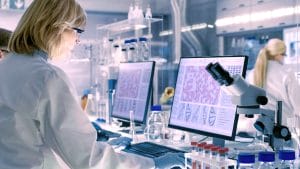Table of Contents
Pathology is a vital and rapidly evolving medical specialty that helps to diagnose, prevent and treat disease. In recent years, there have been several exciting trends in Pathology that are likely to shape the future of diagnosis.
These trends include the increasing use of molecular diagnostics, the development of new immunohistochemical and genomic techniques, and the expanding use of big data analytics in pathology. Each of these trends has the potential to improve our ability to detect and treat disease. This article is not about speech pathology.
Here are the top 19 Trends in Pathology
1. The Rise Biomedical Information
Pathology has undergone a dramatic shift in the past decade with the incorporation of biomedical information into the practice of pathology.
This change is developing by the ever-growing availability of molecular information and the advent of new technologies that have allowed for more sophisticated analysis of tissue specimens.
The result has been a newfound ability to detect and diagnose diseases at the molecular level, often long before they cause any detectable symptoms.
The Rise of Precision Medicine
Precision medicine is a term used to describe the use of technology and data to improve the accuracy and effectiveness of patient care.
Precision medicine is still developing and operated by healthcare professionals in other medical fields for many years, but it is only recently that healthcare professionals have applied to pathology.
Pathology is the study of disease, and precision medicine can help to improve the accuracy of diagnoses and the selection of treatments.
Digitized Workflow from Electronic Microscopes to the Cloud
Pathology is a field of medicine that deals with the diagnosis and treatment of disease. It has traditionally been a paper-based field, but there has been a move towards digitization in recent years.
This has led to the development of new technologies such as electronic microscopes and cloud-based pathology workflows.
These new technologies are improving the accuracy and efficiency of pathology diagnosis and treatment.
Deep Learning for Automation
Pathology is the study of the structure and function of the body’s organs and tissues. Pathologists use a variety of techniques to examine cells and tissues, including microscopy, immunohistochemistry, and molecular biology.
Pathology is a vital field of medicine, and pathology departments are essential to hospitals and other healthcare facilities.
Pathology is a complex field, and pathologists face many challenges in their work. One challenge is that Pathology is constantly evolving.
Artificial Intelligence for Better Augmentation, Prognosis, and Prediction
Pathology is the study of the structure and function of the body’s organs and tissues. It is a vital part of medicine, making it possible to diagnose and treat diseases. Pathology is developing to determine the cause of death in cases where this is not immediately obvious. There has been a growing trend towards using artificial intelligence (AI) in pathology in recent years. This has led to better augmentation, prognosis, and prediction of disease trends.
Pathologists use a variety of techniques to examine tissues and organs, including microscopy, immunohistochemistry, and molecular biology. Pathology is an essential part of modern medicine, providing information that helps doctors diagnose and treat diseases.
Artificial intelligence is a branch of computer science that deals with the design and development of intelligent computer systems.
Biotechnology
The field of pathology is constantly evolving with the rapid advancement of technology.
There has been a shift towards precision medicine in recent years, which aims to target treatments specifically for an individual’s unique genetic profile. Pathology biotechnology plays a pivotal role in this shift by providing researchers with the tools needed to identify and characterize disease-causing mutations.
This information is then used to develop targeted therapies that are more likely to be effective for each individual patient.
Pathology and Radiology Diagnostics
Pathology and radiology are both essential in diagnosing various diseases. Pathology is the study of diseases, while radiology uses imaging to diagnose and treat disease.
Although the two specialties have different focuses, they both play an essential role in diagnosing illness.
One similarity between pathology and radiology is the use of technology. Both specialties use technology to help them diagnose disease.
Trends in Pathology – Digitalization Process
The digitalization process of pathology is inevitable and is currently underway. The benefits of the digitalization process include improved accuracy, efficiency, and cost-effectiveness.
There are several diagnostic challenges that healthcare professionals must attend to, such as standardization of terminology and data sharing. Pathology is a critical part of the healthcare system, and the digitalization process will impact patient care.
Trends in Pathology Tissue Diagnosis – Anatomical
Anatomical pathology is the study of disease diagnosis through the examination of organs and tissues. This field has seen many changes in the past few years, with the advent of new technologies and techniques.
One such trend is the use of molecular pathology to detect diseases at the molecular level.
This approach offers many advantages over traditional histopathology, including increased accuracy and the ability to detect very small amounts of disease.
Advances in Molecular Taxonomy
Pathologists use a variety of techniques to examine tissues and organs to determine the cause of disease.
Pathology is making advances in molecular taxonomy, which is helping to improve the diagnosis and treatment of human diseases. Molecular taxonomy is a technique that uses molecular methods to identify and classify organisms. This technique is to identify and classify pathogens causing human diseases.
There have been many advances in molecular taxonomy in recent years, which have led to new and improved ways of identifying and classifying diseases.
One of the most notable advances has been the development of next-generation sequencing technologies, which allow scientists to sequence the DNA of organisms quickly and cheaply.
Trends in Pathology’s Dedicated Tissue Banks
Pathology is a field of study in which tissues and organs examine and determine the cause of disease.
Tissue banks are essential resources for pathology, providing tissues for research and diagnosis. In recent years, there has been a trend toward the establishment of dedicated tissue banks, separate from other types of banks. This trend has several attributes and factors, including the need for high-quality tissues and the increasing demand for pathology services.
Pathology has always been a vital part of medicine, and with the advent of tissue banking, it is only going to become more critical. Pathology is a rapidly changing field and one of the latest trends in the move towards dedicated tissue banks.
This will allow for more excellent research and collaboration in the field and improved patient care.
Pathology Construction of Tissue Microarrays
The use of tissue microarrays (TMA) in pathology is a relatively new technology that has become increasingly popular in recent years.
TMA is used to study the distribution and expression of proteins in tumor cells.
They are created by embedding small tissue samples, or “core biopsies,” on a glass slide. The cores are then stained with antibodies that bind to specific proteins, allowing researchers to visualize the distribution of those proteins in the tissue sample.
In recent years, tissue microarrays (TMAs) have become a popular tool in pathology. TMAs can arrange small tissue cores, or “tissue chips,” on a glass slide. This allows pathologists to study many different tissues at once. The construction of TMAs is a relatively straightforward process and can perform in a variety of ways.
Standardization of Processing Protocols – Paraffinized Archival Tissue
Pathologists use a variety of methods to examine tissues, including histology, immunohistochemistry, and molecular pathology.
In order to ensure accurate results, it is vital that pathology laboratories use standardized processing protocols.
One way to achieve this is by using paraffinized archival tissue. Such a technique is the use of paraffin wax to preserve tissue specimens. Paraffinization preserves tissue morphology and allows for better staining results. Paraffin wax is a common histological fixative that helps to stabilize tissues for examination.
However, the use of paraffin wax can be labor-intensive and time-consuming.
Immunohistochemical and Molecular Research
Immunohistochemistry is a branch of pathology that uses antibodies to detect proteins in tissues.
Molecular research is a branch of pathology that uses DNA sequencing to identify gene mutations. These three branches of pathology are essential for understanding the causes of disease. Immunohistochemistry can identify the location and type of protein present in a tissue sample.
Molecular research can be used to determine the genes that are responsible for diseases.
Shortage of Pathologists Worldwide
Pathologists are in short supply worldwide, and the shortage is having a significant impact on the diagnosis of healthcare patients.
For example, in Asia and the Pacific region, there is only one pathologist for every 10,000 people. The lack of pathologists is also contributing to longer wait times for test results and diagnoses.
In some cases, patients are being sent to other countries for care because there are not enough pathologists in their home country to provide a diagnosis.
Trends in Pathology – Advances in Genetics
Pathology in genetics is the study of how genes cause diseases and how they are passed down from parents to their children.
Trends in Pathology, particularly in genetics have led to the discovery of many genetic diseases and the development of treatments for them.
In recent years, there have been many Trends in Pathology, especially in the field of genetics. Genetic tests can now diagnose diseases at an early stage, and they can also be used to help guide treatment decisions.
Advances in Information Technology
Pathology has undergone many advances in information technology in recent years. Pathologists are now using sophisticated computer programs to help them diagnose diseases.
There have been trends in Pathology using robotics and technology in recent years. For example, new robotic systems can help pathologists diagnose cancer more quickly and accurately. Additionally, image-guided surgery systems can help to ensure that surgical procedures are with precision.
Furthermore, traditionally, pathology has been taught through the use of textbooks and classroom lectures. However, with the advances in virtual reality technology, there is now a new way to learn pathology.
VR technology can create realistic 3D simulations of diseased organs, which can help students to understand better the complex structures and processes involved in Pathology.
Advances in Digital Imaging
In recent years, advances in pathology have led to the development of digital imaging techniques. Digital imaging is a process that uses a computer to create images of tissues and organs. This allows pathologists to view tissue specimens in greater detail than ever before.
There have been numerous trends in Pathology that have made it possible to diagnose diseases through digital images. This has led to more accurate diagnoses and better treatment outcomes for patients. One of the main benefits of using digital pathology is that it allows for faster turnaround times for diagnostic tests. This means that patients can get the treatment they need sooner.
Trends in Pathology Advances Histopathology
One of the most important techniques used by pathologists is histopathology. Histopathology is the study of tissues and organs using a microscope.
This technique allows pathologists to identify the cause of disease at a microscopic level.
There have been various trends in Pathology in histopathology that have allowed for the diagnosis of diseases that were not previously detectable.
These advances include the use of new staining techniques and immunohistochemistry.
Conclusion: Trends in Pathology: The Future of Diagnosis
In conclusion, pathology is evolving at a rapid pace. New diagnostic techniques are constantly developing and innovating by biomedical engineers, which is likely to continue in the future.
This means that patients can expect to receive more accurate diagnoses and that treatments can be tailored to their individual needs.
Pathologists can detect diseases at earlier stages with new technology and techniques and provide patients with more accurate diagnoses. This allows for better treatment plans and improved patient outcomes.
Pathologists, therefore, have a vital role to play in modern medicine, and we can expect to see even more progress in the field in the years to come.














